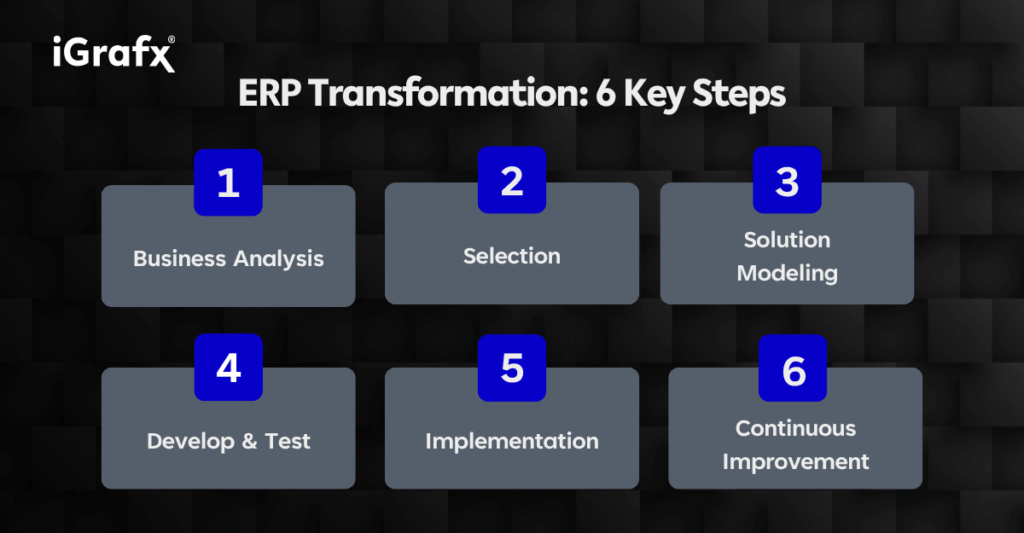Process models are an essential part of any ERP transformation initiative, fostering alignment between teams on how the system is used today, enabling well-informed design of to-be processes, and highlighting compelling post-transformation roadmaps.
However, process models are too often cast aside once the transformation is complete either due to scarcity of resources or knowledge to maintain them, or even through a lack of appreciation of the potential value they bring to the post-project lifecycle.
We recently hosted a webinar, titled “Achieving a Successful ERP Transformation with Process Modeling”, exploring precisely this topic with Toke Mortensen, Senior Consultant at Cornerstones, one of iGrafx’s strategic partners, in which he made an important point regarding ERP transformations that deserves repeating:
“ERP transformations are business projects, not IT projects.”
A common trap in any transformation project – and a particularly dangerous one in ERP transformations – is the temptation to think of the project primarily in terms of its technical components, while overlooking its impact on business processes.
It’s easy to get excited about installing shiny new architecture that is resistant to crashes and can handle larger workloads, but such transformations inevitably entail major changes to core business processes that need to be taken into proper consideration to get the most out of.
In the webinar, which can be viewed on demand here, Mortensen explains how building up critical business process knowledge ensures a successful ERP transformation:
“You need a process model that facilitates a common language across the organization; sales needs to understand production, and vice versa. This is crucial to succeeding within ERP projects and making sure that the solution is aligned across the entire organization.”
He goes on to outline a six-phase project workflow, and the ways that process modeling facilitates each stage:
Phase 1: Business analysis
“By mapping out business and process models containing the full process landscape, we can identify gaps and clear out misunderstandings quite early in the project and not suffer in the long run, building up critical business knowledge that we can utilize later on.”
Phase 2: Selection
“This critical business knowledge can even inform the choice of technical solution and accelerate the process of working with partners by allowing them to understand the business quickly, making the selection stage more efficient.”
Phase 3: Solution modeling
“We can utilize the process information we have built up and start to design the future solution with the to-be processes, which will then be utilized when we are developing and building up the system.”
Phase 4: Development and test
“We utilize the to-be processes throughout the test phase, basing our test cases on the process documentation and using the process diagrams as the description of the test cases. This reduces the time spent on creating long texts for the steps that are contained within these test cases.”
Phase 5: Training and implementation
“The process diagrams can also be used as the foundation for training materials, giving us head start when we build that material at the end of the project.”
Phase 6: Continuous improvement
“Even after implementation, we can utilize all the knowledge we built up when looking into potential process improvements, automation, and AI and build up a full improvement pipeline.”
As businesses gain process knowledge throughout ERP projects like these, they can combine their process models with their development management tool of choice, which enables them to answer several important questions:
- What are the interdependencies between processes?
- What relevant variations and scenarios exist within a process?
- Which processes are involved in which end-to-end flows?
- Which roles are supported by which systems?
- Which systems are supporting which processes?
- Which processes and activities contain ERP customizations?
Even after implementation has been finalized, and they move into the post-project stage, it’s still possible to gain value from the process model information that was gathered throughout the project.
Permission management
Process models enable businesses to thoroughly analyze permission management, looking into which roles need access to which systems, thereby reducing license costs and creating an efficient access governance setup. In this way, businesses can ensure that permissions are continuously maintained and avoid having too broad of a license base for the users.
This can all be done using information that has been built up throughout the project – not additional information that needs to be added.
System updates
Many organizations favor using cloud solutions that have continuous updates coming in every year. Once again, the business knowledge acquired through process modeling will allow them to analyze the types of customizations used, which processes they are used in, and which test cases they affect.
From there, they can build up efficient test packages for each ERP update that focus on the right test cases and test the right parts of the system to make sure that everything is running after the update.
This reduces the risk of system failures after updating, due to pre-emptively identifying and testing relevant process variants.
Continuous improvement
Once a business has completed an ERP implementation, they then turn their attention to continuous improvement and identifying potential areas for optimization.
This can be done through process workshops or brainstorm sessions using the process diagrams and data from the process model to highlight where to make improvements first, then build up an improvement and automation pipeline within the process model.
While building a comprehensive process model during the initial stages of an ERP transformation project can streamline the execution of the transformation itself, retaining that process model and using it as a tool to guide post-project activities is something that many businesses overlook. Yet it plays a vital role in ensuring continuous improvement and informing critical business decisions in the months and even years after the project is completed.
It is for this reason that Mortensen’s statement at the beginning of our webinar – “ERP transformations are business projects, not IT projects” – is so important to take into account.
To view the full webinar “Achieving a successful ERP transformation with process modeling” on demand, please click this link.
Or, for a complete demonstration of the Process360 Live platform, contact us today.


